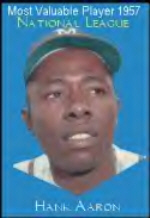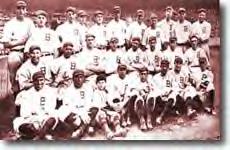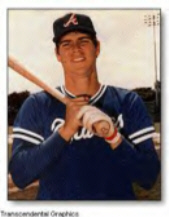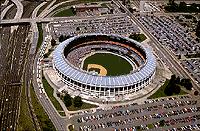 This is the story of the oldest continuously operating professional sports franchise in America. It's a story not only a great teams (the 1914 'Miracle' Braves, the 1995 World Champs) and great ballplayers (Aaron, Spahn, Niekro, and Murphy), and memorable managers and pleasant stadiums, but also a story of heartbreaking losses and long pennant droughts. It's the story of the Braves and their ancestors - the Red Stockings, Beaneaters, Doves, Rustlers, and Bees - and their wanderings from Boston to Milwaukee and Atlanta and, in a way, it's also the story of professional baseball in America.
In fact, the franchise that started as the Boston Red Stockings in the 1870s and is now known as the Atlanta Braves, is the only one of today's 28 Major League franchises to have fielded a team every season professional baseball has been in existence.On January 20, 1871, the Boston Red Stockings were incorporated by Ivers Whitney Adams with $15,000 and the help of Harry Wright, the "Father of Professional Baseball," who had founded and managed America's first truly professional baseball team, the Cincinnati Red Stockings. Two months later, the Red Stockings became one of nine charter members of the National Association of Professional Baseball Players and the forerunner of the National League.
Like the current Braves, Wright's Red Stockings, were a dominant force. They won six of the first eight pennants in history - National Association flags in 1872-1875 and National League championships in 1877-78. In 1875, they won 26 straight games, and won all 38 home games at the Union Base Ball Ground in Boston's South End.
This is the story of the oldest continuously operating professional sports franchise in America. It's a story not only a great teams (the 1914 'Miracle' Braves, the 1995 World Champs) and great ballplayers (Aaron, Spahn, Niekro, and Murphy), and memorable managers and pleasant stadiums, but also a story of heartbreaking losses and long pennant droughts. It's the story of the Braves and their ancestors - the Red Stockings, Beaneaters, Doves, Rustlers, and Bees - and their wanderings from Boston to Milwaukee and Atlanta and, in a way, it's also the story of professional baseball in America.
In fact, the franchise that started as the Boston Red Stockings in the 1870s and is now known as the Atlanta Braves, is the only one of today's 28 Major League franchises to have fielded a team every season professional baseball has been in existence.On January 20, 1871, the Boston Red Stockings were incorporated by Ivers Whitney Adams with $15,000 and the help of Harry Wright, the "Father of Professional Baseball," who had founded and managed America's first truly professional baseball team, the Cincinnati Red Stockings. Two months later, the Red Stockings became one of nine charter members of the National Association of Professional Baseball Players and the forerunner of the National League.
Like the current Braves, Wright's Red Stockings, were a dominant force. They won six of the first eight pennants in history - National Association flags in 1872-1875 and National League championships in 1877-78. In 1875, they won 26 straight games, and won all 38 home games at the Union Base Ball Ground in Boston's South End.
 By 1912, Boston's National League franchise had come to be known as the Braves and was slowly emerging from a decade of poor performance. After six league titles in the 1870s and three more in the 1890s, the Braves entered a long colorful chapter in its history. The modern era in Boston started slowly, but included two pennants (1914 and 1948) and one World Series title (1914). In fact, the Miracle Braves of 1914 are among the most well-known teams in baseball history. But by 1952, the Braves had lost much fan support to the Red Sox, Boston's American League team.
By 1912, Boston's National League franchise had come to be known as the Braves and was slowly emerging from a decade of poor performance. After six league titles in the 1870s and three more in the 1890s, the Braves entered a long colorful chapter in its history. The modern era in Boston started slowly, but included two pennants (1914 and 1948) and one World Series title (1914). In fact, the Miracle Braves of 1914 are among the most well-known teams in baseball history. But by 1952, the Braves had lost much fan support to the Red Sox, Boston's American League team.
No one expected the Boston Braves to move to Milwaukee, the home of the Braves' top minor-league affiliate, after 82 years in Boston. Braves owner Lou Perini had promised to help Milwaukee attract a Major League team and most people thought it would be the struggling St. Louis Browns. In the Spring of 1953, Perini cited declining fan support in Boston and announced his attention to move the Braves. NL owners unanimously approved, much to the delight of Milwaukee fans. At a parade, 60,000 people citizens cheered the new team. And one of the happiest chapters in Braves history had begun.Immediately, fans in Milwaukee and throughout the state of Wisconsin showered the Braves were unconditional love. The Braves' players were adored on the field where attendance at the new County Stadium made Boston seem like a distant memory. Off the field, it was not uncommon for businessmen to provide free dry cleaning, free meals, free beer (of course), free cars and whatever they may have wanted besides. Led by young stars like Hank Aaron and Ed Mathews and by pitching veteran Warren Spahn (all three future Hall of Famers), the Braves slowly climbed into the National League's elite.
After the struggles of the mid- and late 1980s, Atlanta baseball fans were ready for a winner and the Braves delivered in the 1990s. From the stunning worst-to-first pennant race of 1991, which captivated the city for months, to the World Championship team of 1995 and the stellar performances of teams in 1996-1998, the Braves have been far and away the most successful Major League Baseball team of the 1990s.
1990
The Braves made history by becoming the first team ever to reach the World Series just one season after having baseball's worst record. Although the team stumbled into the All-Star break 9.5 games behind the first-place Dodgers, they were able to slice seven games off the lead in the first 12 days after the break. What followed was a thrilling stretch drive during which the Braves and Dodgers were never separated by more than 2.5 games after August 10... The Braves finally clinched the division title on October 5, after an eight-game winning streak, the first six coming on the road, to set Atlanta records of 94 wins (including a 55-28 mark in the second half) and 2,140,217 in attendance. Steve Avery was the MVP of the NLCS after tossing a record 16.1 consecutive scoreless innings to lead the Braves to a seven-game triumph. Tom Glavine won the Cy Young Award; Terry Pendleton won the batting title and was named N.L. MVP; Bobby Cox became the BBWAA and AP N.L. Manager-of-the-Year; Schuerholz earned UPI N.L. Executive-of-the-Year honors; and BASEBALL AMERICA honored Atlanta by naming it the Organization-of-the-Year.
1992
The Braves became the first NL team to win back-to-back pennants since the 1977-78 Dodgers, while setting a new franchise record with a major league-leading 98 victories. On May 27, the Braves resided in last place with a 20-27 mark, 7.0 games behind front-running San Francisco. The team then proceeded to rip off 21 wins in 24 games en route to finishing the season with an amazing 78-37 (.678) run over the duration of the campaign. The Braves finally moved into first place July 22, then were tied for the top spot on two occasions before gaining the lead for good on August 2. The Braves led the league in ERA (3.14) for the first time since 1958. For the second straight year, Tom Glavine won 20 games, including a 13-game winning streak, which established a modern day Braves' record. John Smoltz won a career-high 15 games, and became the first Braves' hurler to lead the NL in strikeouts (215) since Phil Niekro in 1977. Atlanta then met Toronto in the first International World Series, with the Blue Jays prevailing in six games. Nonetheless, the Braves repeated as league champions for the first time since 1957-58.
1993
After one of the most pulsating stretch runs in baseball history, the Braves became the first team to win the N.L. West for three consecutive years when they captured the division over the Giants on the season's final day. The Braves set a franchise record with 104 victories, leading the majors in wins for the second straight season. Atlanta's "Fab Four" starting rotation lived up to expectations, with Greg Maddux winning his second consecutive Cy Young Award after posting a 20-10 mark with a 2.36 ERA. Tom Glavine (22-6, 3.20 ERA) became the first N.L. pitcher to win 20+ games for three straight years Steve Avery (18-6, 2.94 ERA) matched his career-high in victories, and John Smoltz (15-11, 3.62 ERA) gave the Braves four 15-game winners for the first time this century. The Braves could point to their 104 wins, third consecutive division title, their top-ranked minor league system and franchise record attendance of 3,884,720 as evidence of their standing as one of the model organizations in the majors.
1994
The Braves opened the campaign in the newly aligned National League attempting to capture their fourth straight division crown in their new home, the N.L. East. The Braves began the season in record fashion, winning their first seven games,all on the road. It was the second best start in Atlanta history and a modern N.L. record for consecutive wins on a season-opening road trip. The Braves equalled their Atlanta-best 13-1 start, which included tying a team record 10 straight road wins. The Braves set an Atlanta record for runs scored in their 19-5 victory at Chicago April 15. Bobby Cox became the 41st manager in major league history to win at least 1,000 games with a 6-5 victory June 17 vs. Cincinnati. esented Atlanta in the All-Star game in Pittsburgh. Maddux started for the National League, and McGriff captured the MVP award after he hit a three- run homer in the ninth inning to tie the game at 7-7. (The NL won in 10 innings, 8-7.) Maddux reached the record books by becoming the first player in major league history to win three straight Cy Young Awards. Maddux finished 16-6, tied for the lead league in wins, and led the league in ERA (1.56), complete games (10), innings pitched (202.0) and opponents batting average against (.207). Hopes of another division crown and a third trip in four years to the World Series were dashed when the players went on strike after the games of August 11. The strike eventually forced the cancellation of the playoffs and World Series for the first time since 1904.
1995
1996
1997
In their inaugural season at Turner Field, the Braves won a major league high 101 games and an unprecedented sixth straight division title and set a major league record for April with 19 victories, breaking the old mark of 18, set six times previously. The team clinched the N.L. East on September 22, finishing with a 9.0 game margin over Florida. Atlanta's pitching once again proved dominant, leading the majors with a 3.18 ERA and 17 shutouts. Fourth starter Denny Neagle turned in the National League's only 20-victory campaign, going 20-5 with a 2.97 ERA, while Greg Maddux (19-4, 2.20) narrowly missed fhe 20-win circle. John Smoltz (15-12, 3.02) led the National League with 255.0 innings pitched, and became the first pitcher in franchise history to notch at least 200 strikeouts in four seasons. Tom Glavine (14-7, 2.96 ERA) was one ot four Braves starters to rank in the top lO in the N.L. in ERA. On offense, the Braves reached the .270 mark for the second straight year, a feat they hadn't accomplished since 1947-48. Most noteworthy were the 12 grand slams hit by the squad, setting a major league record, featuring 3 by Chipper Jones in a span of l3 contests, setting the NL record for 3 slams in fhe fewest team games. C. Jones posted another solid season (21-111 -.295), with 20 stolen bases. Ryan Klesko led the squad with 24 homers, followed by Javy Lopez (23), Fred McGriff (22), and C. Jones (21). Jeff Blauser added 17 homers, while batting .308. Rafael Belliard made headlines when he belted his first homer in more than 10 years, a 2-run blast Sept. 26 at New York. In the post-season, Atlanta swept 3 games from Houston in the Division Series, giving the Braves a 9-1 mark in Division Series competition. Competing in a record 6th straight National League Championship Series, the Braves lost to the Marlins in 6 games losing the final 2 contests, marking the first time a team other than Atlanta represented the National League in the World Series since 1993.
1998


By 1963, rumors were rampant that the Braves would leave town and by the end of the '65 season, they signed the papers to go. That didn't mean the city of Milwaukee and State of Wisconsin would go down without a fight. After a series of court battles, injunctions and appeals, the team finally arrived in Atlanta in 1966. The Atlanta Braves were born and the Milwaukee Braves were put to rest. The Braves were welcomed with a parade and quickly grew comfortable in their new home, Atlanta Stadium. It only took a few years for the Braves to return to their winning ways. The Team of the 90s
 The Braves created shock waves August 4 when they traded Dale Murphy, one of the most respected athletes in Atlanta history, to the Philadelphia Phillies for Jeff Parrett, Jim Vatcher and Victor Rosario. The move enabled David Justice to return to right field and he responded with 20 home runs and 50 RBI over the last two months. Justice wound up hitting .282 with 28 homers and 78 RBI, enough to earn him Rookie-of-the-Year accolades. The team struggled, however, and finished sixth in the NL West for the third straight year.
The Braves created shock waves August 4 when they traded Dale Murphy, one of the most respected athletes in Atlanta history, to the Philadelphia Phillies for Jeff Parrett, Jim Vatcher and Victor Rosario. The move enabled David Justice to return to right field and he responded with 20 home runs and 50 RBI over the last two months. Justice wound up hitting .282 with 28 homers and 78 RBI, enough to earn him Rookie-of-the-Year accolades. The team struggled, however, and finished sixth in the NL West for the third straight year.
 The Braves validated their label as the "Team of the 90's" by winning their first World Series in 38 years. the world championship was the first for the city of Atlanta in a major professional sport, while the Braves also entered the record books as the first franchise to win the World Series in three different cities. Atlanta overcame a 23-20 start (3rd place, 5.0 GB) to post a 67-34 (.663) mark from June 14 through the remainder of the regular season, running away with the N.L. East title by 21.0 games. By winning the division, the Braves became the first N.L. team to finish first in four consecutive completed seasons since the 1921-24 New York Giants. Greg Maddux claimed his unprecedented fourth straight Cy Young Award, going 19-2 with a 1.63 ERA. Mark Wohlers emerged as the dominant closer the Braves had sought throughout the 90's, saving 25 games, including 21 straight chances between May 15 and September 3. Fred McGriff (27), David Justice (24), Ryan Klesko (24) and Rookie of the Year Chipper Jones (23) became the first Braves foursome to hit over 20 homers in a season since 1973, and Javy Lopez matched Joe Torre's 1966 record for the best average by an Atlanta catcher with a .315 mark. Atlanta beat the Rockies three games to one in the Division Series, and routed the Reds in the first-ever four-game sweep of an NLCS, before winning the world title with a six-game triumph over the Indians, climaxed by Series MVP Tom Glavine's one-hitter over eight innings and David Justice's decisive sixth-inning homer in the 1-0 finale.
The Braves validated their label as the "Team of the 90's" by winning their first World Series in 38 years. the world championship was the first for the city of Atlanta in a major professional sport, while the Braves also entered the record books as the first franchise to win the World Series in three different cities. Atlanta overcame a 23-20 start (3rd place, 5.0 GB) to post a 67-34 (.663) mark from June 14 through the remainder of the regular season, running away with the N.L. East title by 21.0 games. By winning the division, the Braves became the first N.L. team to finish first in four consecutive completed seasons since the 1921-24 New York Giants. Greg Maddux claimed his unprecedented fourth straight Cy Young Award, going 19-2 with a 1.63 ERA. Mark Wohlers emerged as the dominant closer the Braves had sought throughout the 90's, saving 25 games, including 21 straight chances between May 15 and September 3. Fred McGriff (27), David Justice (24), Ryan Klesko (24) and Rookie of the Year Chipper Jones (23) became the first Braves foursome to hit over 20 homers in a season since 1973, and Javy Lopez matched Joe Torre's 1966 record for the best average by an Atlanta catcher with a .315 mark. Atlanta beat the Rockies three games to one in the Division Series, and routed the Reds in the first-ever four-game sweep of an NLCS, before winning the world title with a six-game triumph over the Indians, climaxed by Series MVP Tom Glavine's one-hitter over eight innings and David Justice's decisive sixth-inning homer in the 1-0 finale. The Braves made their fourth trip to the World Series out of the last five played, but were unable to defend their world title as the Yankees took the championship in six games. In their final season at Atlanta-Fulton County Stadium, the Braves took over first place for good on May 19, en route to winning the N.L. East by 8.0 games. The division crown was Atlanta's fifth straight, marking the first time a National League team has registered five straight first-place finishes. The Braves bowed out of Atlanta-Fulton County Stadium by setting a franchise mark with 56 home wins, topping the old record of 51, set three times previously. Atlanta's .270 team BA was its best since hitting .272 in 1983. The pitching staff set a major league record by fanning 1,245 batters, breaking the Astro's major league mark of 1,221 set in 1969. John Smoltz continued the Brave's Cy Young reign, as the right-hander fashioned a breakthrough season, going 24-8 with a 2.94 ERA. He set modern day franchise records with his 276 strikeouts and a 14-game winning streak. Greg Maddux didn't win a fifth straight Cy Young Award, but went 15-11 with a 2.72 ERA, while Tom Glavine went 15-10 with a 2.98 ERA and won his 3rd Silver Slugger Award. Stellar years at the plate were enjoyed by Chipper Jones (30-110-.309), Fred McGriff (28-107-.295), Ryan Klesko (34-93-.282) and Marquis Grissom (23-74-.308). Grissom won his 4th consecutive Gold Glove Award and collected a career high 207 hits. On June 2 at Cincinnati he also became the first Brave to complete a straight steal of home since Ed Miller performed the feat in 1979. Other offensive highlights included Jeff Blauser's 7-RBI game at Philadelphia May 11 and Jermaine Dye's homer in his first major league AB May 17 vs. the Reds (the first debut HR by a Brave since Chuck Tanner in 1955). The 1996 season also saw the debut of 19-year-old phenom Andruw Jones on Aug. 15, who made the jump from A-ball to the majors in under two months. At 19 years, 3 months and 23 days, he became the fourth-youngest player in Atlanta history, and in his second game, the next day, he socked his first M.L. homer, becoming the youngest National Leaguer to go deep since Houston's Larry Dierker in 1965. The Braves organization was recognized by BASEBALL AMERICA as the Organization-of-the-Year for 1996, the second time since 1991.
The Braves made their fourth trip to the World Series out of the last five played, but were unable to defend their world title as the Yankees took the championship in six games. In their final season at Atlanta-Fulton County Stadium, the Braves took over first place for good on May 19, en route to winning the N.L. East by 8.0 games. The division crown was Atlanta's fifth straight, marking the first time a National League team has registered five straight first-place finishes. The Braves bowed out of Atlanta-Fulton County Stadium by setting a franchise mark with 56 home wins, topping the old record of 51, set three times previously. Atlanta's .270 team BA was its best since hitting .272 in 1983. The pitching staff set a major league record by fanning 1,245 batters, breaking the Astro's major league mark of 1,221 set in 1969. John Smoltz continued the Brave's Cy Young reign, as the right-hander fashioned a breakthrough season, going 24-8 with a 2.94 ERA. He set modern day franchise records with his 276 strikeouts and a 14-game winning streak. Greg Maddux didn't win a fifth straight Cy Young Award, but went 15-11 with a 2.72 ERA, while Tom Glavine went 15-10 with a 2.98 ERA and won his 3rd Silver Slugger Award. Stellar years at the plate were enjoyed by Chipper Jones (30-110-.309), Fred McGriff (28-107-.295), Ryan Klesko (34-93-.282) and Marquis Grissom (23-74-.308). Grissom won his 4th consecutive Gold Glove Award and collected a career high 207 hits. On June 2 at Cincinnati he also became the first Brave to complete a straight steal of home since Ed Miller performed the feat in 1979. Other offensive highlights included Jeff Blauser's 7-RBI game at Philadelphia May 11 and Jermaine Dye's homer in his first major league AB May 17 vs. the Reds (the first debut HR by a Brave since Chuck Tanner in 1955). The 1996 season also saw the debut of 19-year-old phenom Andruw Jones on Aug. 15, who made the jump from A-ball to the majors in under two months. At 19 years, 3 months and 23 days, he became the fourth-youngest player in Atlanta history, and in his second game, the next day, he socked his first M.L. homer, becoming the youngest National Leaguer to go deep since Houston's Larry Dierker in 1965. The Braves organization was recognized by BASEBALL AMERICA as the Organization-of-the-Year for 1996, the second time since 1991.
Another amazing season for the Braves. The team wins 106 games and its seventh straight division title. The Braves met the Chicago Cubs in the Divisional Playoffs and won in three straight games. The San Diego Padres were the opponents in the NLCS. After losing the first three games, the Braves won two dramatic contests in San Diego, before falling in six games. There were a number of notable individual perfromances. Tom Glavine won the NL Cy Young Award, his second, with a 20-6 record and 2.47 ERA. Newcomer Kevin Millwood has an outstanding season, as do John Smoltz and Greg Maddux. The offense was no less impressive. In his first season with the Braves, Andres Galarragga hits .305. Andruw Jones continued his rapid development with outstanding defensive play in centerfield. Chipper Jones had another fine year, hitting .313. Despite the team's premature exit from the postseason, 1998 left fans looking forward to another great year in 1999.
excerpts taken from atlantabraves.com
History
2001 Schedule
Chipper Jones
Javy Lopez
Fab 5
Other Braves
Former Braves